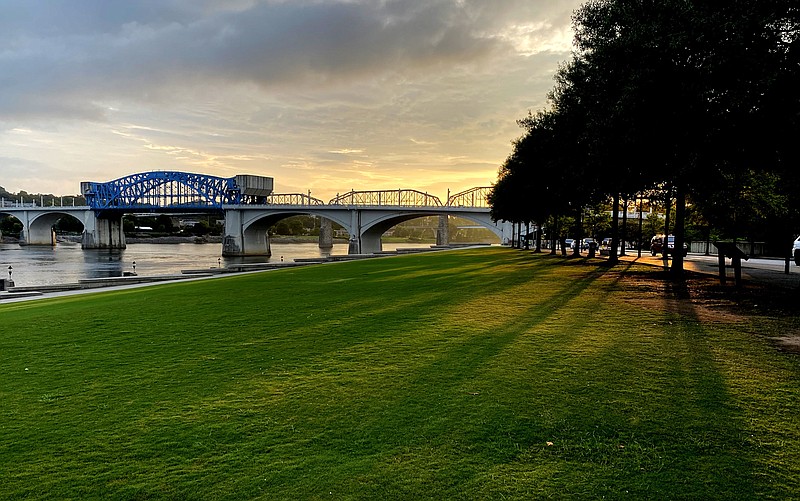When it comes to history, politicians and generals get all the glory, while no one gives credit to the engineers. Stephen Harriman Long is an interesting example. Were it not for Long, the city of Chattanooga might not exist.
Here's the story:
The state of Georgia was about 10 years ahead of Tennessee when it came to railroads. By the mid-1830s, the Peach State had several railroads in the works with names such as the Central of Georgia Railroad, the Monroe Railroad and the Georgia Railroad. All three were intended to link the Atlantic coastline and Savannah River with points in the interior of the state.
Then, in 1836, the Georgia government took the rather unusual step of starting a taxpayer-owned railroad called the Western and Atlantic. The idea of the W&A was to connect the interior of the state -- the intended destination of the many railroads already in the works -- to the Tennessee River. The W&A hired Stephen Harriman Long, an explorer and cartographer who had helped build the Baltimore and Ohio Railroad, to be its lead surveyor.
Sometime in the late 1830s, a member of Long's team drove a stake in the ground 7 miles east of the Chattahoochee River. The town that grew up around "Zero Mile Post" was originally called Terminus.
Long and his colleagues then surveyed what route best connected Terminus to the Tennessee River. There were two main choices. One was for the railroad to head west to Gunter's Landing -- the place in northeast Alabama where the Tennessee River abruptly turns west. The other was for the railroad to head northwest to Ross's Landing -- another place where the river turns west, but this time in southeast Tennessee.
Meanwhile navigation problems along the Tennessee River were foremost on everyone's mind. The Tennessee River passed through many barriers to navigation just downstream from Chattanooga -- boulders, turns, shoals, whirlpools and other obstacles with names such as the Whirl, the Suck and the Boiling Pot. These river barriers would be eliminated when the Tennessee Electric Power Co. built Hales Bar Dam three quarters of a century later. However, in the 1830s they were still huge impediments to commerce.
Long and his team studied both routes and recommended Ross's Landing. Their report was published in the Sept. 18, 1839, Republican Banner of Nashville.
Long pointed out that:
-- The Gunter's Landing route would be about 45 miles longer than the Ross's Landing route.
-- The Gunter's Landing route would have to pass over Alabama's Sand Mountain, "which can only be crossed by means of three, perhaps four, inclined planes, at an ascent of more than 100 feet per mile." And "there is no gap or depression in Sand Mountain by which these appalling difficulties can be avoided."
-- Gunter's Landing was more inclined to flood than Ross's Landing.
The other reason many officials favored Ross's Landing over Gunter's Landing is a belief that either the state of Tennessee or a private company would build another railroad heading southeast from Nashville to hook up with it. A route directly west from central Georgia to Gunter's Landing wouldn't exactly be taking the short route toward Nashville -- not to mention Louisville, Kentucky, further north.
The railroad went along with Long's recommendations. And, to summarize a lot of history:
-- The town that sprung up at the former site of Ross's Landing became known as Chattanooga.
-- Gunter's Landing changed its name to Guntersville.
-- Terminus changed its name to Marthasville. Then, so the story goes, another railroad engineer named J. Edgar Thompson came up with the idea that the place instead be called "Atlantica-Pacifica." By 1845 that had been shortened to Atlanta.
About the same time Marthasville changed its name to Atlanta, construction began on the Western and Atlantic Railroad. The W&A made it to Cartersville, Georgia, by the end of 1846, and Dalton by the end of 1847. The last 50 miles of the railroad took much longer than the first 100 miles because a 1,500-foot tunnel had to be dug just north of Dalton, in the town now known as Tunnel Hill.
The ceremony that marked the completion of the Western and Atlantic Railroad occurred on Dec. 1, 1849 -- the day the first locomotive arrived in Chattanooga from Atlanta. A railroad official dipped a cup into the Tennessee River, mixed it with salt water he had brought from Charleston and Savannah, then poured them both into the river. According to the Atlanta Constitution, "he pronounced that this mingling of the waters of the three states symbolized their union and fraternity which must be as lasting as their waterways" -- a concept to be tested sooner, and more seriously, than anyone present could have imagined.
Stephen Harriman Long was not present at that 1849 ceremony. As superintendent of the construction of the Marine Hospital in Louisville, Kentucky, Colonel Long had better things to do than attend ceremonies.
Bill Carey is the founder of Tennessee History for Kids, a nonprofit organization that helps teachers cover social studies.

